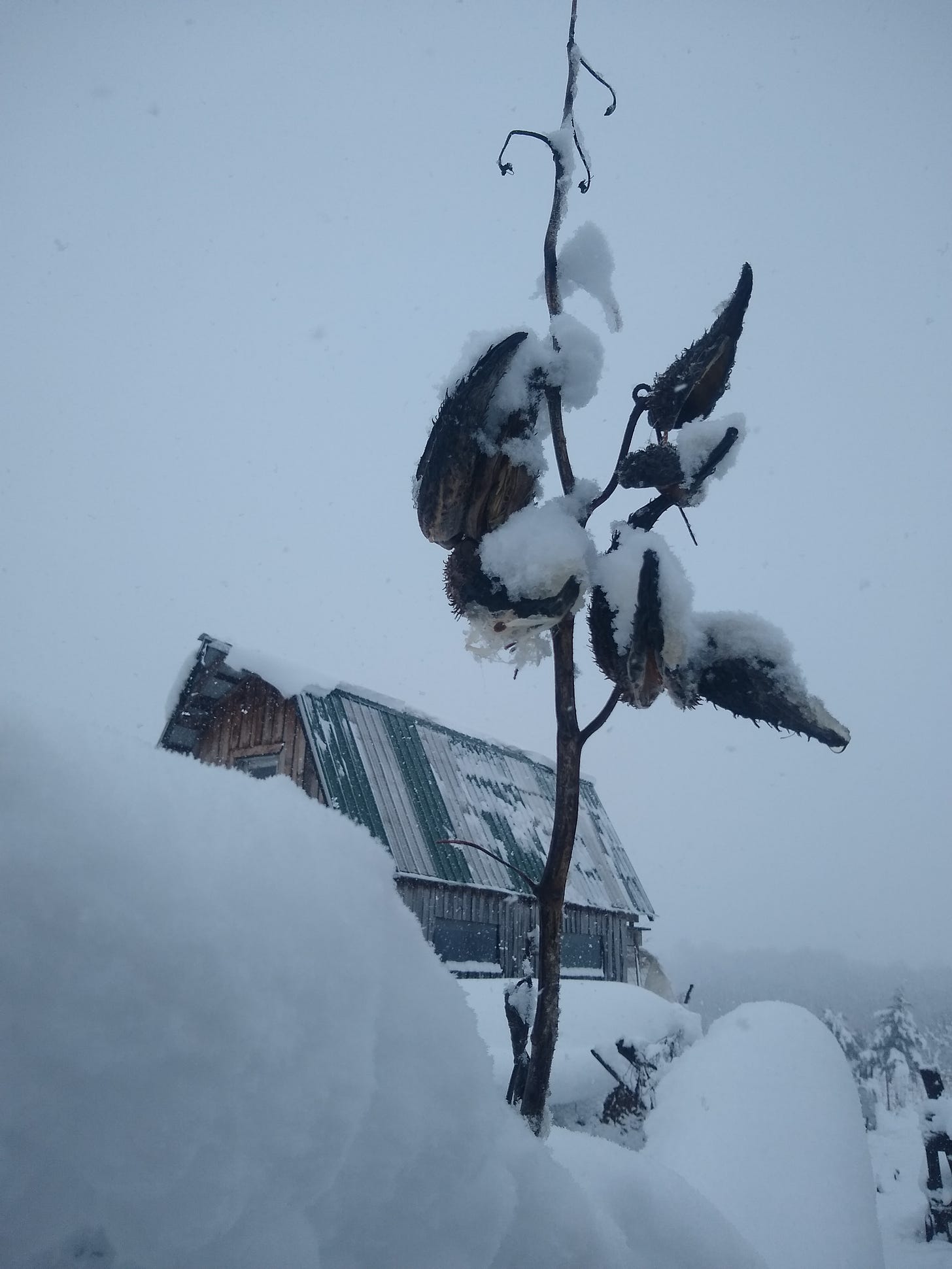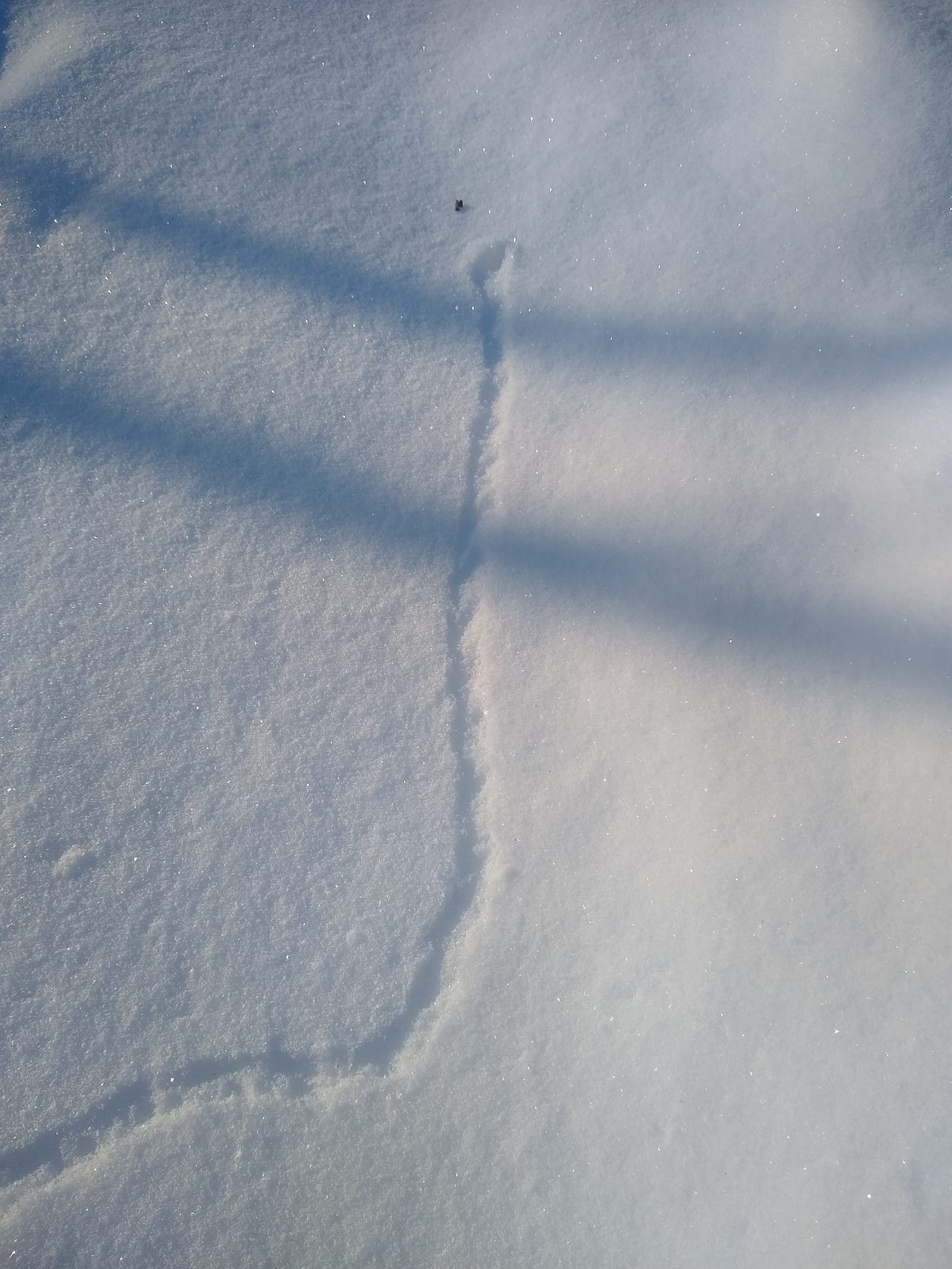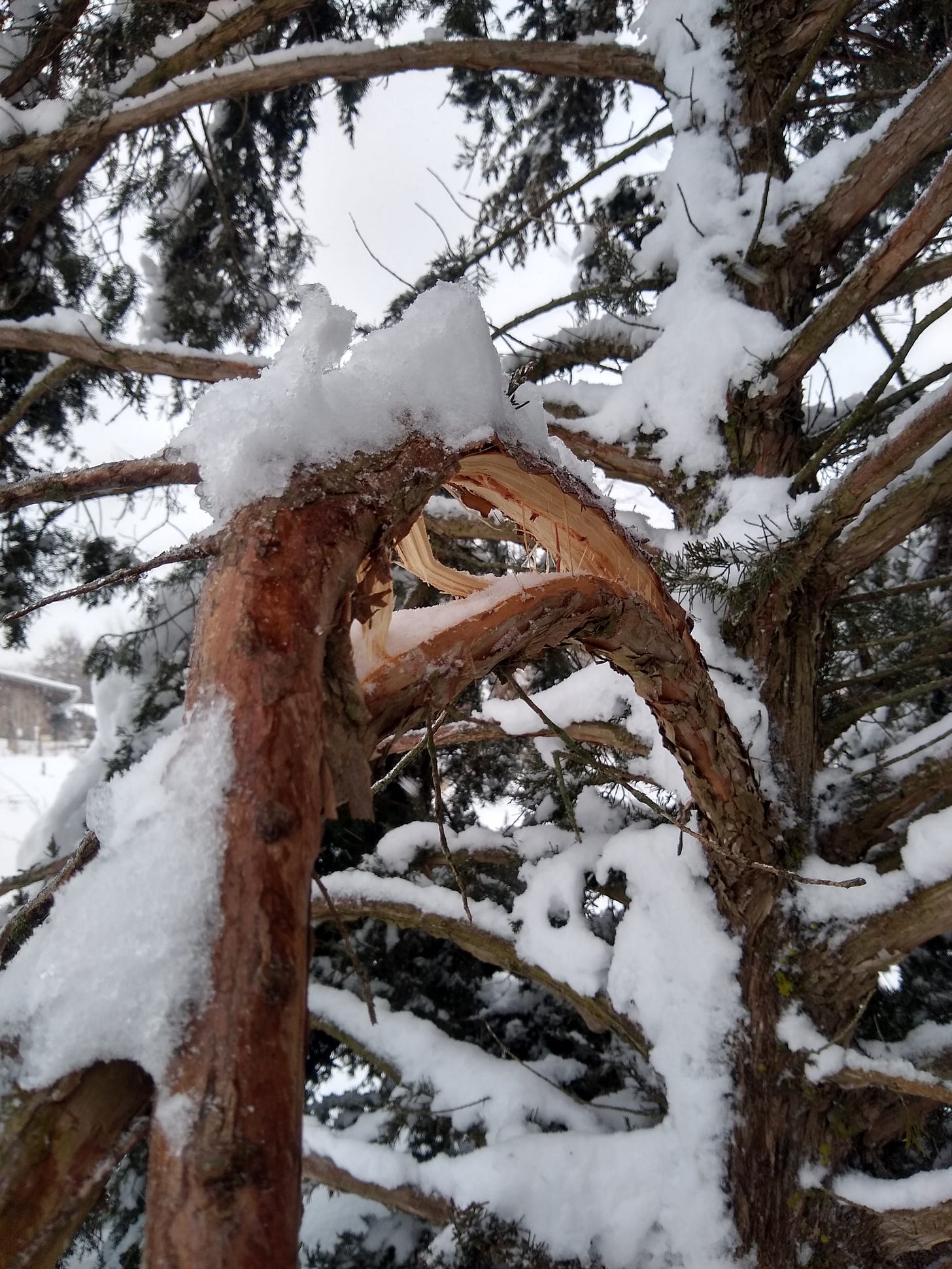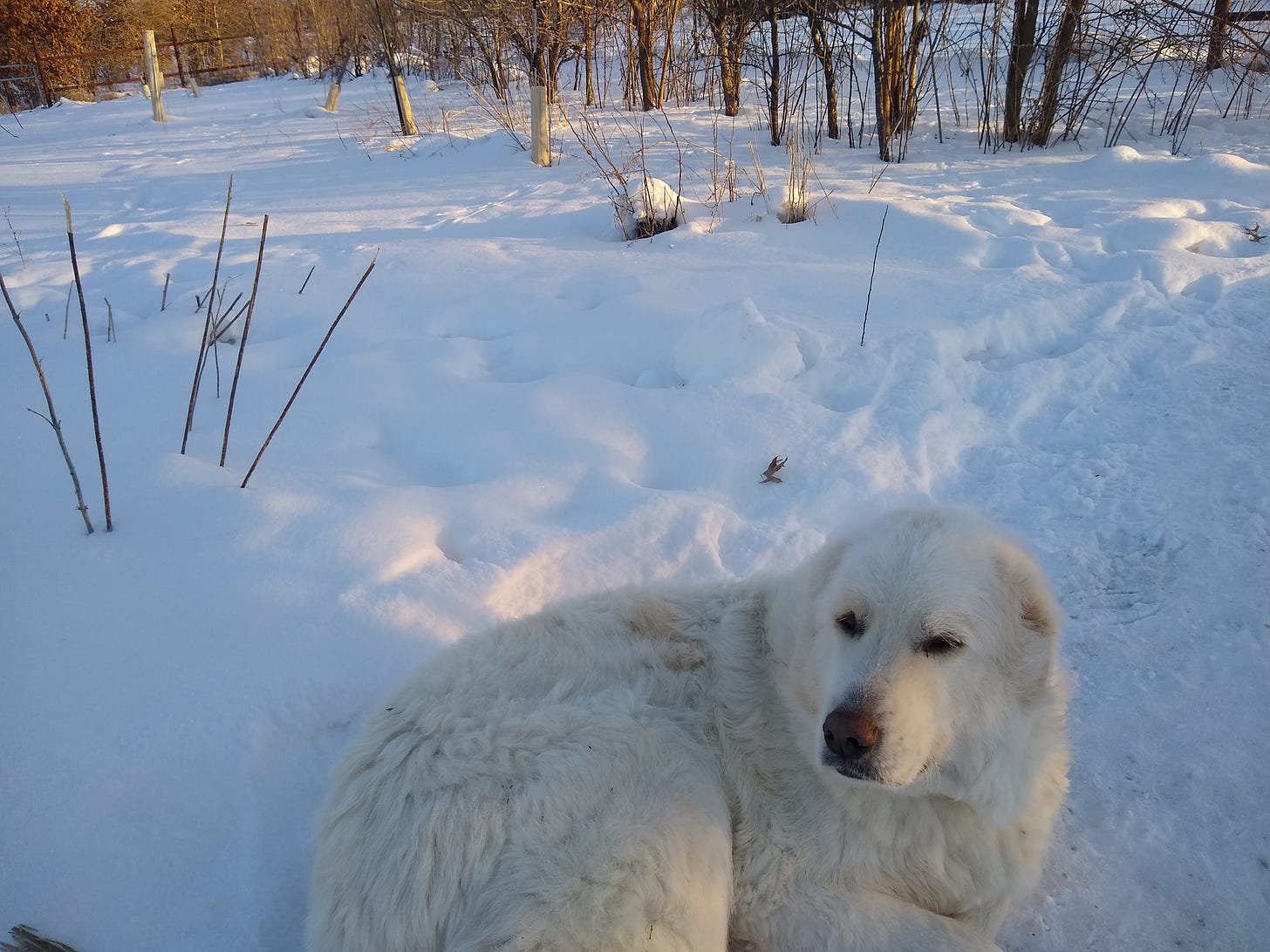Snotcicles above a Subnivean Landscape
Time seems frozen, and ephemeral patterns and habitats feel permanent in the distortion of deep winter. They're not.
Right now, it may be hard for those of us in North America to remember that 2023, which ended around three weeks ago, was the hottest year for global temperatures on record. And much like most of my elder, farming neighbors, I may too have uttered, under my frozen breath, that I could sure use a bit of that global warming, perhaps a few days ago, while I was being sprayed with icy water while kneeling in the subzero snow after chipping a channel to the unfrozen center of of a 500 gallon rain tank with a mallet and a small chisel, or shortly thereafter when my hands stuck to the mittens I picked back up. January is often the apex of cold around here, thought I’ve been through a rough February or two. The omnipresent snow that does not shrink or disappear on even the sunniest days has served to smother any memory of the summer of 2023, flavored as it was with the constant hint of Canadian wildfire smoke. For now at least, I am still assured that the weather will change at some point. Of the many things that are difficult to predict related to our ever shifting climate is whether or not things will just get gradually warmer, or rather, gradually more extreme, with disrupted jet streams and complex ocean currents threatening to deepen the cold in historically warmer areas, all the while turning up the heat globally in summer. Probably whatever’s worse. But right now, it is a full 6 degrees Fahrenheit, and that is above zero. Along with low winds and bright sun, working in 6 degree conditions has me feeling blessed, compared with previous days.
I am also blessed with naturally luxuriant nostril hair. In the course of living my earthy lifestyle, I do my best to avoid interfering with this adaptive feature, though I do, on occasion, perform some base-level trimming, once things begin outgrowing my nose hole. Nostril hairs can help filter dust, smoke and pollen from entering the respiratory tract, but they do have a drawback, namely their tendency to hold onto nasal effluent. We’re talking snot and boogers here. On a cold and sunny day such as this, when I am both well-bundled in insulative layers but engaging in strenuous outdoor activities, like shoveling, breaking ice, and hauling bedding, I have the tendency to get flushed, and begin exuding copious nasal secretions. And when this stuff attempts to exit the head, it will freeze to my nose hair on impact. Exhalation after snotty exhalation, the stream freezes and thaws hundreds of times, and as a result, a snotcicle is formed. This is one of the many wonders of frozen physics I have been fortunate enough to witness winter after winter here at Fox Holler Farmstead.
Aside from snotcicles, we do have icicles here as well, and observing where and how they form and project under certain conditions does quite a lot to help clarify water flow patterns on the farm. Over time, this personally logged data has helped me correct various drainage-based hazards relating to our self-built, and often complex and unconventional roofing infrastructure. Icicles also offer access to long, sharp, pokey things, always joyful items for children both, literal and inner, to behold and play with. If you can bear the painful winds and bone-cracking cold of midwinter, time spent moving across and falling into the deep and marooning landscape of snow drifts and ice encrusted trails, there is much to learn and wonder at.
For days, particularly those with a low barometric pressure, the haunting musk of a nearby fox has crept across the slope, its tracks erased by fine, windblown snow. But over time and in between storms, the network of tracks –rabbit, fox, and small rodent– reveal themselves in the sudden stillness. I have followed fox tracks to dens, outlined with scraps of cottontail fur and feathers. The oak-filled draws are pocked with the freshly dug dirt of opened squirrel caches, and hedge balls trapped in the thorny embrace of their mother trees trail the nibbled flesh and pith of excavated seeds.
The faint trace of a vole tunnel.
The snowpack near our own den holds a frozen midden of secreted bones and ham rinds buried by our canine friends, somewhere between the earth’s frozen skin of seed and thatch and the unrelenting polar air. In places, I have fallen into waist high drifts, but the typical snow-depth out away from the packed hoof paths and sled trails is somewhere between mid-boot and knee. This is the subnivean world, that ephemeral complex of vole tunnels, mouse caves, and shrew chutes supported by a protective canopy of dormant vegetation. In this world we cannot see, small mammal life is thriving, nibbling on secret seeds and insulated grass. In years like this, when it appears deep snow cover may remain consistent for extended periods, we find many woody plants take a hit, from the dogwoods and brambles of the prairie to the saplings of the wood and orchard. Similar to the cycle of fire, I imagine that occasional deep and cold winters help to regulate the success of woody plants on the prairie and affect the overall balance of vegetation.
Several of our North American hazelnut shrubs and serviceberries are smashed flat by the heavy ice, their arching limbs laid in the snow for rabbits and voles to strip. A few years ago, I’d have spent a day shoveling out these shrubs: now I just leave them be. Both species resprout prodigiously here, and I tend to think of the rodent damage as rejuvenating, at least among some species. There are, however, areas with more vulnerable plantings, adrift in snow. With too short of tree guards, even trees that stand tall in the snow are accessible to a populace of rabbits that grow hungry.
The rabbits, much like the voles, shrews, and mice that inhabit the subnivean terrain, take shelter in the snow topped umbrella canopies of Eastern Red Cedar, and the thorny, complex frameworks of multiflora rose. The ice-laden boughs of mulberry and willow, planted in our pig and poultry yard hang down in the pathways under the burden of snow, some of them cracking. Between some necessary trimming here and there, and my dabbling attempts at coppice agroforestry in the fertile shadow of the barnyard, I have begun producing sled-loads of bundled sticks. I feed some to our goats and pigs, and toss small armloads of the tender twigs to the rabbits dwelling in the thorny, problematic bramble patches as future kindling for concentrated burning. I don’t like them in my garden, but I do pity them, I guess. The goats particularly relish the tender tips and buds and young, nutritious bark. Over time, they debark whole piles of this woody fodder, making for a quick drying kindling for springtime cooking or feedstock for our biochar kiln.
Damage, breakage, and death come part and parcel with the deep freeze of midwinter. As organic gardeners, we take comfort in the freeze, knowing that the armies of garden pests, herds of deer, and colonies of rabbits are all sure to take on some casualties– the great winter reordering. The weak will die and remain meat for scavenging packs of coyotes and the sharpened, seeking beaks of eagles. Woody plants will break or be browsed, some resprouting, others subsumed in the soil as carbon.
Like the squalls of spring or the windfall riches of summer storms, the disturbance wreaked by pounding blizzards and deathly cold do play a role and offer advantages in our ecosystem, but these advantages do not necessarily carry over to the loving and careful management of livestock. The work has been non-stop– hauling water by the sled load, collecting eggs before they freeze, tearing apart the iced-glazed exterior of great bales of hay we must roll into the loafing yard, pulling skittering tarp loads of bedding across the ice-encrusted Missouri tundra– the daily “have-to’s” take a majority of our time, leaving little opportunity for reflection at home. Our livestock can usually endure the brutality of the cold for days at a time, but even interspersed with double-digit air temps and sun, as we occasionally have been, they cannot withstand weather like this for an excessive duration, as they move through their bodily energy reserves. At some point, they can become fatigued, drawing from an empty well of calories for warmth. At the moment, none of our stock appears particularly vulnerable, even old Curly Sue, our first and most ancient nanny goat, who, unlike the rest of our herd, is allowed a bit of grain in the cold for conditioning. All that said, we have a new calf due to drop in less than a week. Luckily, the forecast will transition to more favorable temperatures by then, but as for now, it’s cold enough for these politicians to keep their hands in their own pockets for a change.
Our dogs are quite nonplussed by all of this, and while they do tend to head into the poultry barn overnight, they lay about in the snow during daylight hours, occasionally soothing their itchy coats by rolling on their backs in the middle of the footpaths until the ice becomes polished and slick. In my daily ambulations, these glazed patches are difficult to discern. Yesterday morning, with a pail full of hot molasses water, one of these treacherous patches took me out, in a manner rather cartoonish, my legs jettisoning skyward, arms outstretched, my ass already brittle from the cold dropping to the frozen ground instantly. Somehow, managed to save most of the water though, and with as many pants as I had on, the physical impact was mostly dampened, briefly along with my spirits.
To underdress in winter comes at the cost of certain peril. But the layers requisite in keeping one’s core temperature at a survivable level are worn at the cost of freedom of movement. Dressed for my sub zero chores, it is a challenge to lift my legs high enough through deep snow, and the ear flaps of my rabbit fur hat render the world silent. My mittens can scarcely grip tools at times, and I am constantly holding them between my knees as I bare-handedly open frozen metal gates. The gear is arduous to move in, and impossible to gracefully remove in the throes of my morning constitutional in our frigid outhouse. Life here has a rhythm, governed by the seasons and our responsibilities as farmers, but beyond my morning coffee and that first extremely cold shit I need to take (these early wake-up tasks are always accomplished simultaneously), the day before me, obscured by the veil of pre-dawn, is largely unknowable in the deep freeze. Plastic made brittle by cold breaks, well-trod pathways are erased by dunes of snow, and I know not when the ice dam on the barn shed may let loose and crash, perhaps impaling the row of ducks that stand squarely below it with its icicle fangs. What I do know is that many folks who wear those full-body insulated coveralls have not struggled against them in a frozen outhouse in the wee hours, and that life appears much more ordered and cozy down in the tracks and tunnels of subnivea.
Sometimes an owl can make out the faint sounds of creatures rustling in their snow tunnels, perhaps nibbling seeds, chomping on the frozen remnants of earthworms sent above ground by December’s warm rains, or performing their own daily constitutional duties in their subnivean latrines, and you can find their outspread wing prints and cratered claw marks in the seemingly barren snowscape. The ordered world beneath our feet and out of the harsh wind is ephemeral, and less stable than it feels. Next week looks to bring balmy weather and consistent rains, and as I do my best to shake off the creaking slumber of the deep freeze and resume caring for calves, slaughtering goats, cutting wood and mapping fields, this ephemeral time, the alleged “rest” of midwinter will all but fade like the filthy slush soon to be under my boots. But before I hang up the winter gear and enter a new cycle of growth, care and dissemination, let’s hope I don’t break my butt bone in the process.
While in areas of permafrost the subnivean layer beneath the snow and above the natural terrain can remain a stable ecosystem, with a stable temperature, places with dynamic climates (and growing more dynamic each year) do not afford us such predictable familiarity. It can be easy to feel like this freeze will last forever, and it won’t. I find it hard to rest appreciably when I understand that I must begin to plan gardens, order seeds, strategize grazing, set goals, and fully exit winter ready to go through the cycles of seasonal labor again. Snow cover or not, we’ll be casting pasture seed within a month, and unlike these fragile tunnels, we’ll remain steadfastly on the landscape, trapped in the flux of a shifting climate, our boots planted firmly in pursuit of this absurd work, lest we slip and fall or become otherwise erased from this ecosystem we refuse to join by our own folly.
Sore-assed and almost ready for what’s next,
BB







I had been looking for an answer to the question of why noses run more when coming in from the cold - so glad to finally have that resolved.
Love hearing how life continues, even during the quiet season. And how it later shapes the more active seasons. Thanks for a great post.
My imagination in reading this piece is stoked to a fair glow, Benjamin, thanks so much for taking time out and presenting it all, in an enjoyable read. As a long-time country girl gone city.. and I see we here in the city haven’t a clue or never have a reason to think about these things, what it takes to keep a farm, the amazing network of goings-on in the subnivean layer, let alone the existence of such a thing as snotcicles and the necessity of not messing with nostrils.. and the very many layers required for survival, and minding the survival of livestock.. all very much of the reason for the state we find ourselves, for in the city we exemplify addiction to fossil fuel-everything, faux food, container lives, useless hopes, incessant chatter about nothing.. and sadly, increasingly isolated from the land and each other. Thank you for bridging the gap in your own way, to what’s needed, between those of us who are not there, to what it’s really like to live on the land in real time. Love. ❤️